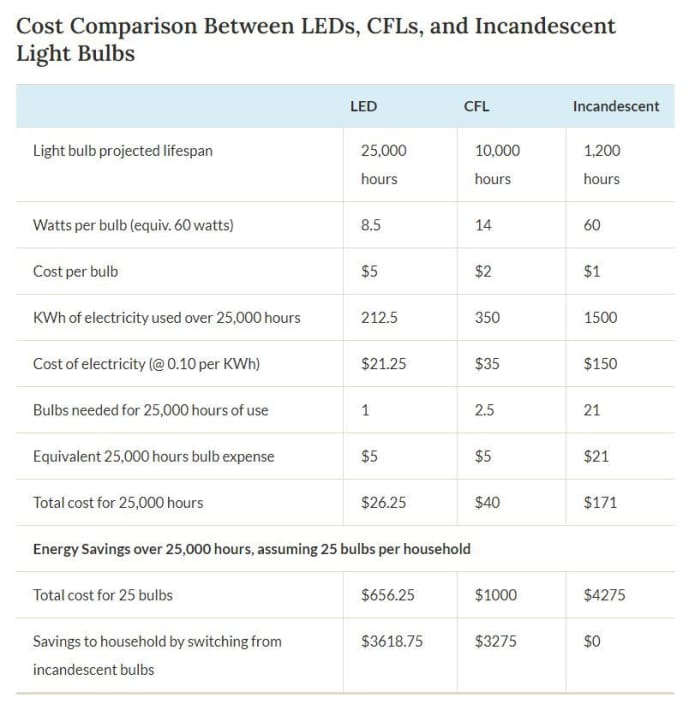[ad_1]
President Joe Biden’s Energy Department will unveil proposed light-bulb efficiency rules that would effectively phase out compact fluorescent bulbs and move U.S. households decisively toward energy-efficient, but potentially more expensive, LEDs.
The Department of Energy is proposing the rule on Monday with the aim to finalize it before the end of Biden’s first term in early 2025. The rule would more than double the current minimum light-bulb efficiency level, from its current standard of 45 lumens per watt to over 120 lumens per watt for the most common bulbs. To reach that efficiency requirement, the days of traditional light bulbs are numbered.
Earlier this year, the DOE implemented a separate phaseout of inefficient incandescent bulbs, with the intent to clear them entirely from store shelves by summer 2023. Now, the new rule will accelerate the transition away from compact fluorescent bulbs as well.
Sales of LEDs, which stands for light-emitting diodes, have increased, gaining to 69% of the light-bulb market in 2020 from about 50% a few years earlier. But as recently as 2020, 30% of sales were still incandescent or halogen incandescent bulbs, according to DOE data. Compact fluorescent light bulbs (CFL) were 3% of the market in 2018, and down to 1% by 2020. These three styles turn most of the electrical energy they use into heat.
The rule to phase out the old-fashioned incandescent bulbs capped a decades-long bipartisan effort started in the Bush administration. But that transition was complicated by former President Donald Trump in 2019, whose administration undid a previous Obama-era light-bulb rule.
What’s the difference between LEDs and traditional bulbs?
While fluorescent bulbs generate light by sending an electrical discharge through an ionized gas, incandescent bulbs emit light by heating the filament present in the bulb. Fluorescent was an earlier, more-efficient-at-the-time replacement for incandescent. With LEDs, an electrical current passes through a microchip, which illuminates the tiny light sources to create visible light.
The DOE says LEDs use at least 75% less power than incandescent bulbs and last up to 25 times longer. According to the department, installing LED bulbs in just your most frequently used light fixtures can save hundreds of dollars over the lifetime of the bulbs.
The Natural Resources Defense Council (NRDC) offered different figures: LEDs use one-sixth the amount of energy to deliver the same amount of light and last at least 10 times longer than incandescent bulbs.
Some of the discrepancies may lie with the fact that LEDs don’t burn out with the pop of the filament as older bulbs do. LEDs grow weaker over time, and according to industry standards, their useful life ends when their brightness is diminished by 30%. Households may then replace them at varying times.
Costs are dropping
Many retailers have greatly expanded their LED options, but continue to stock the old designs as well, which historically had cost less. While home-furnishings chain Ikea switched to selling only LEDs in 2015, including in U.S. stores, nearly all major retailers are still selling fluorescent, incandescent or halogen incandescent bulbs, including Walmart
WMT,
Amazon
AMZN,
Home Depot
HD,
, Lowe’s
LOW,
and Target
TGT,
The Energy Department has said that the average cost of LED bulbs has dropped by nearly 90% since 2008.
“LEDs have become so inexpensive that there’s no good reason for manufacturers to keep selling 19th-century technology that just isn’t very good at turning electrical energy into light,” said Steven Nadel, executive director of the American Council for an Energy-Efficient Economy (ACEEE).
Still, when upfront costs alone are considered, LED bulbs run more than double their fluorescent counterparts.

Figures show a rough comparison and do not account for differing electricity costs by region.
Eartheasy
And the public’s access to LEDs hasn’t been uniform, with communities underserved by retail options finding less choice. Minimal choice typically means shoppers pay up for the rarer LEDs relative to what’s spent per bulb in more affluent shopping districts. One Michigan study from 2018 revealed that not only were LED bulbs less available in poorer areas, they also tended to cost on average $2.50 more per bulb than in wealthier communities.
Larger impact
Speaking on light-bulb efficiency earlier this year, the NRDC said a move to LEDs can result in annual utility bill savings of $3 billion for consumers collectively and because they’re more efficient, prevent 222 million tons of climate-warming carbon pollution
CL00,
over the next 30 years, an amount equal to the annual greenhouse-gas emissions of over 48 million vehicles.
GHG emissions, including those from the electricity sector, are largely responsible for the global warming that is accelerating incidents of cataclysmic weather, drought and other events that risk lives and economic loss. The Biden White House, and most industrialized nations, argue their efforts put the U.S. and other highly polluting nations on track to halve GHG emissions by 2030 and flip to net-zero emissions by 2050.
The Biden team said that the administration will have taken more than 110 actions this year to strengthen energy-efficiency standards, from appliance rebates to solar-panel tax incentives and more.
The administration calculated the average family can save at least $100 annually through lower energy bills in the years to come. Collectively, these energy-efficiency actions will reduce greenhouse-gas emissions by more than 2.4 billion metric tons and save consumers $570 billion cumulatively over 30 years, the administration said.
[ad_2]
Source link
